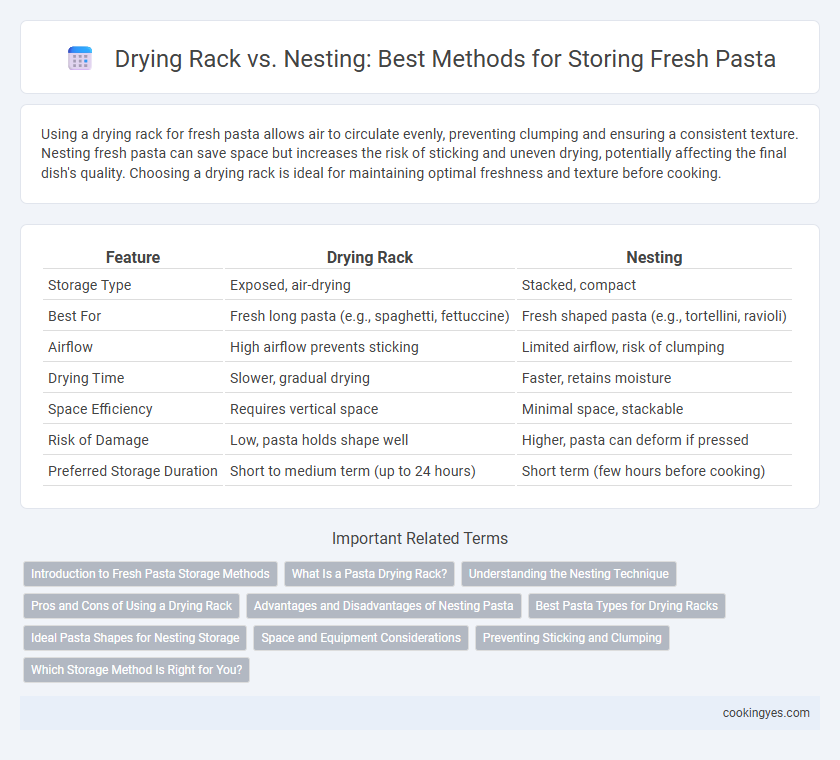Using a drying rack for fresh pasta allows air to circulate evenly, preventing clumping and ensuring a consistent texture. Nesting fresh pasta can save space but increases the risk of sticking and uneven drying, potentially affecting the final dish's quality. Choosing a drying rack is ideal for maintaining optimal freshness and texture before cooking.
Table of Comparison
| Feature | Drying Rack | Nesting |
|---|---|---|
| Storage Type | Exposed, air-drying | Stacked, compact |
| Best For | Fresh long pasta (e.g., spaghetti, fettuccine) | Fresh shaped pasta (e.g., tortellini, ravioli) |
| Airflow | High airflow prevents sticking | Limited airflow, risk of clumping |
| Drying Time | Slower, gradual drying | Faster, retains moisture |
| Space Efficiency | Requires vertical space | Minimal space, stackable |
| Risk of Damage | Low, pasta holds shape well | Higher, pasta can deform if pressed |
| Preferred Storage Duration | Short to medium term (up to 24 hours) | Short term (few hours before cooking) |
Introduction to Fresh Pasta Storage Methods
Fresh pasta storage methods primarily include drying racks and nesting techniques, each suited to different preparation needs. Drying racks allow pasta strands to air-dry evenly, preventing clumping and extending shelf life up to 48 hours. Nesting, where pasta is loosely coiled into mounds, is ideal for short-term storage before cooking, preserving freshness and texture.
What Is a Pasta Drying Rack?
A pasta drying rack is a kitchen tool designed specifically to hang and dry fresh pasta strands evenly, preventing clumping and ensuring optimal texture before cooking or storage. Made from materials like wood or stainless steel, these racks feature multiple arms or rods where long pasta such as spaghetti or fettuccine can be draped to air dry naturally. Using a drying rack maintains pasta's shape and moisture balance, contrasting with nesting methods that may cause sticking or uneven drying.
Understanding the Nesting Technique
The nesting technique for fresh pasta storage involves gently coiling individual strands or sheets into small bundles, preventing tangling and promoting even drying. Unlike drying racks that expose pasta strands to air on separate arms, nesting reduces surface exposure, which helps retain moisture and prevents brittleness. Properly nested pasta should rest on a floured surface or tray, optimizing space while maintaining the pasta's texture and shape during short-term storage.
Pros and Cons of Using a Drying Rack
Using a drying rack for fresh pasta storage allows even airflow around the strands, preventing clumping and promoting consistent drying, which reduces the risk of spoilage. The open design of drying racks supports maintaining shape and texture but can expose pasta to dust or pests if left uncovered. Drying racks also require sufficient space and time, making them less convenient compared to nesting methods that save room but may cause sticking or uneven drying.
Advantages and Disadvantages of Nesting Pasta
Nesting fresh pasta allows for efficient portion control and prevents individual strands from tangling, making it easier to handle and cook. However, nesting can cause the pasta to stick together if not properly dusted with flour, leading to clumps during cooking. Compared to drying racks, nesting requires less space but may increase the risk of uneven drying and potential spoilage if moisture is trapped within the nests.
Best Pasta Types for Drying Racks
Drying racks are ideal for long, thin pasta varieties such as spaghetti, fettuccine, and linguine, as these shapes benefit from ample airflow to prevent clumping and ensure even drying. In contrast, nesting suits short, thick pasta like gnocchi or tortellini, which require gentle drying to maintain shape and texture. Using the appropriate storage method enhances pasta preservation and cooking quality by optimizing moisture evaporation and structural integrity.
Ideal Pasta Shapes for Nesting Storage
Ideal pasta shapes for nesting storage include filled pastas like ravioli and tortellini, as well as short shapes such as orecchiette and gnocchi that naturally stack without sticking. Nesting allows these pasta forms to maintain their delicate structure and moisture content better than drying racks. This method prevents deformation and ensures vibrant texture, crucial for preserving the quality of fresh pasta before cooking.
Space and Equipment Considerations
Choosing between a drying rack and nesting bowls for fresh pasta storage depends largely on kitchen space and equipment availability. Drying racks require vertical space and allow air circulation, preventing clumping and ensuring even drying, ideal for small batches if ceiling or counter height is sufficient. Nesting bowls consume less vertical space but demand careful stacking to avoid sticking, making them better suited for compact kitchens with limited equipment.
Preventing Sticking and Clumping
A drying rack allows fresh pasta to air-dry evenly, preventing strands from sticking and clumping by providing ample space and airflow. Nesting fresh pasta in small bundles minimizes surface contact, reducing the risk of adhesion but requires careful spacing to avoid moisture buildup. Both methods effectively prevent sticking when pasta is lightly dusted with flour before storage.
Which Storage Method Is Right for You?
Choosing between a drying rack and nesting for fresh pasta storage depends on your kitchen space, pasta type, and cooking frequency. Drying racks provide optimal airflow, preventing clumping and ensuring even drying, ideal for long or ribbon-shaped pasta like fettuccine. Nesting is compact and suitable for short-term storage of delicate shapes such as tortellini but requires careful handling to avoid sticking.
Drying rack vs nesting for fresh pasta storage Infographic

 cookingyes.com
cookingyes.com